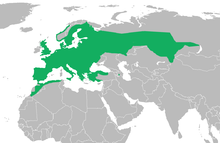| Common toad | |
|---|---|

| |
| Scientific classification | |
| Domain: | Eukaryota |
| Kingdom: | Animalia |
| Phylum: | Chordata |
| Class: | Amphibia |
| Order: | Anura |
| Family: | Bufonidae |
| Genus: | Bufo |
| Species: | B. bufo
|
| Binomial name | |
| Bufo bufo | |

| |
| Range map of common toad | |
| Synonyms[2] | |
|
List
| |
The common toad, European toad, or in Anglophone parts of Europe, simply the toad (Bufo bufo, from Latin bufo "toad"), is a toad found throughout most of Europe (with the exception of Ireland, Iceland, parts of Scandinavia, and some Mediterranean islands), in the western part of North Asia, and in a small portion of Northwest Africa. It is one of a group of closely related animals that are descended from a common ancestral line of toads and which form a species complex. The toad is an inconspicuous animal as it usually lies hidden during the day. It becomes active at dusk and spends the night hunting for the invertebrates on which it feeds. It moves with a slow, ungainly walk or short jumps, and has greyish-brown skin covered with wart-like lumps.
Although toads are usually solitary animals, in the breeding season, large numbers of toads converge on certain breeding ponds, where the males compete to mate with the females. Eggs are laid in gelatinous strings in the water and later hatch out into tadpoles. After several months of growth and development, these sprout limbs and undergo metamorphosis into tiny toads. The juveniles emerge from the water and remain largely terrestrial for the rest of their lives.
The common toad seems to be in decline in part of its range, but overall is listed as being of "least concern" in the IUCN Red List of Threatened Species.[1] It is threatened by habitat loss, especially by drainage of its breeding sites, and some toads get killed on the roads as they make their annual migrations. It has long been associated in popular culture and literature with witchcraft.
